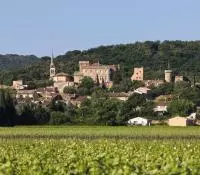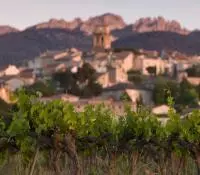AOC Côtes du Rhône Villages Rochegude
Even in France, there are few sites that can trace their roots back 2,000 years. But Rochegude is one of them; it was mentioned by Emperor Domitian in the 1st century AD. It’s been recognised by other famous wine lovers more recently too; former US President Thomas Jefferson fell for its charms when he visited the Rhône in the late 18th century.
The style has evolved over time, but what hasn’t changed is the terroir. Part slope, part flat, the vines flow down from a rocky hillside, down into sand, clay and flint soils below.
This diversity is a strength; winemakers can blend between them to create varied styles of red wine (and even a little white and rosé). Their generous, sunwarmed reds major on Grenache and Syrah, but they’re big fans of Carignan here, bringing density and heartiness to the blend.
Today the Rochegude torch is carried by just a handful of faithful winemakers and a strong co-operative cellar, carrying this historic wine forward to be enjoyed by future generations in years to come.

Informations
Climate: Mediterranean influenced by Mistral wind
Soils: Clay / Rocky
Website appellation : https://www.cotesdurhone.com/
Key figures
Production surface area in 2023: 132 HA
Total production in 2023: 4 181 HL
Average annual yeld: 32 HL/HA
Recognition in AOC by the I.N.A.O.: 1967
Commune : Rochegude
Grape varieties
Main grape varieties
- Bourboulenc,
- Clairette,
- Grenache blanc,
- Grenache noir,
- Marsanne,
- Mourvèdre,
- Roussanne,
- Syrah,
- Viognier
Secondary grape varieties
- Bourboulenc,
- Brun argenté (locally known as Camarèse or Vaccarèse),
- Carignan,
- Carignan blanc,
- Cinsault,
- Clairette,
- Clairette rose,
- Counoise,
- Floréal,
- Grenache blanc,
- Grenache gris,
- Marsanne,
- Muscardin,
- Piquepoul blanc,
- Piquepoul noir,
- Rolle (or Vermentino)
- Roussanne,
- Terret noir,
- Ugni blanc,
- Vidoc,
- Viognier
To know
Histoire
Emperor Domitian is known to have mentioned the vineyards of Rochegude several times. His steward, Cassius Severianus, tasked with restoring and rejuvenating the Gaulish vineyards, is known to have stayed here. As proof, there is stil a vine growing in Rochegude today called La Cassieuse.
In the 18th century, the quality of the local vineyards grew under the watchful eye of the Marquis of Acqueria, a committed wine-grower.
This constant effort to improve the quality of Rochegude wines was rewarded in 1967, when the area was promoted to Côtes du Rhône Villages with geographic name.
Climate
Mediterranean type climate influenced by the Mistral wind.
Soils
Red clay; light, porous sandstone with some flinty areas.
Geography
The vines grow only in the commune of Rochegude, in the southern Drôme département.
Varieties and flavours
The appellation’s red wine blends must contain mostly Grenache supplemented by Syrah and/or Mourvèdre. The resulting wines are dense, deeply coloured and well-structured, and will keep for several years. Over time, their ripe fruit flavours mellow to develop toasty, woody notes.
For whites, Grenache blanc, Clairette, Marsanne, Roussanne, Bourboulenc and Viognier are the main varieties in the blend. These are fruity, well-balanced wines, with good aromatic intensity and fruit flavours.
Associated appellations


